Discover Florida Nature
It's time to explore the natural Florida


|
|
|
|
|
Prohibited species may be imported and possessed for research, following
approval of the research plan, including security measures to prevent
escape; and by public aquaria, zoological parks, or public exhibitors
with current accreditation by the American Zoo and Aquarium Association
or the American Association of Museums. Prohibited species may not be
kept as personal pets, with the exception of red-eared sliders that
were in possession prior to July 1, 2007. No exceptions are made for
piranha or pirambeba; these species are banned and may not be possessed
by anyone at anytime. 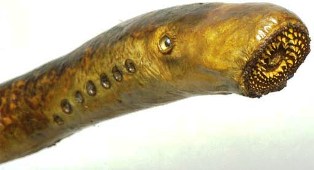 Lampreys
(Petromyzon marinus) These are among the earliest fish (280
million years in archaeological records) and are parasitic using a
sucking-disk shaped mouth with rasping teeth that wear a hole in the
flesh of its victim. Found in temperate waters throughout the world, the
lampreys have eel-like bodies, that are cartilaginous, with no jaws,
scales or paired fins. Lampreys use the sucker shaped mouth to attach to
the prey and then use rasping teeth to bore through the skin and an
anticoagulant to allow them to feed on body fluids. The lampreys created
major environmental problems when canal construction allowed them to
enter the great lakes. The entire family Petromyzonidae is prohibited. Lampreys
(Petromyzon marinus) These are among the earliest fish (280
million years in archaeological records) and are parasitic using a
sucking-disk shaped mouth with rasping teeth that wear a hole in the
flesh of its victim. Found in temperate waters throughout the world, the
lampreys have eel-like bodies, that are cartilaginous, with no jaws,
scales or paired fins. Lampreys use the sucker shaped mouth to attach to
the prey and then use rasping teeth to bore through the skin and an
anticoagulant to allow them to feed on body fluids. The lampreys created
major environmental problems when canal construction allowed them to
enter the great lakes. The entire family Petromyzonidae is prohibited.  Piranha
(Serrasalmus) Piranhas have deep laterally compressed
bodies that are generally silvery or golden in color, with a short
adipose fin. Piranha jaws have a single row of sharp tricuspid sheering
teeth and no molars. Other characids look somewhat similar but can be
distinguished primarily by the dentition. In telling Piranhas from
Metynnis and other silver dollars, the angle of the jaw is a pretty good
characteristic for sorting them, a forward jutting lower jaw that forms
a V at the angle is a piranha, even upper and lower jaw profile that
forms a U at the angle of the jaw is not a piranha. Native to rivers in
South America, piranha are able to bite pieces out of larger prey, as
opposed to having to swallow their prey whole, as do most North American
freshwater fishes. Piranha often feed in schools and exhibit
feeding-frenzy behavior. Most piranha are less than 2 pounds but they
can grow up to 16 inches and 6 pounds. The entire subfamily
Serrasalminae is prohibited in Florida due to its predatory nature,
human safety concerns and their proven ability to spawn and survive in
south Florida. Piranha
(Serrasalmus) Piranhas have deep laterally compressed
bodies that are generally silvery or golden in color, with a short
adipose fin. Piranha jaws have a single row of sharp tricuspid sheering
teeth and no molars. Other characids look somewhat similar but can be
distinguished primarily by the dentition. In telling Piranhas from
Metynnis and other silver dollars, the angle of the jaw is a pretty good
characteristic for sorting them, a forward jutting lower jaw that forms
a V at the angle is a piranha, even upper and lower jaw profile that
forms a U at the angle of the jaw is not a piranha. Native to rivers in
South America, piranha are able to bite pieces out of larger prey, as
opposed to having to swallow their prey whole, as do most North American
freshwater fishes. Piranha often feed in schools and exhibit
feeding-frenzy behavior. Most piranha are less than 2 pounds but they
can grow up to 16 inches and 6 pounds. The entire subfamily
Serrasalminae is prohibited in Florida due to its predatory nature,
human safety concerns and their proven ability to spawn and survive in
south Florida.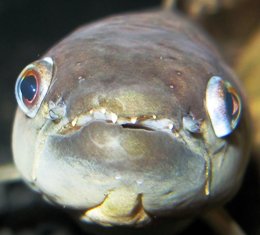 Trahiras
(Erythrinis) The Trahira has a strong jaw with irregularly
spaced sharp teeth, no adipose fin, rounded caudal fin, big scales,
large eyes, and the anal fin is behind the dorsal with pelvic fins below
the dorsal. Primarily found in South American rivers, trahiras also
inhabit lakes and back waters. Salinity tolerance allows trahiras to
favor the mouths of rivers. A large fish-eating predator that is taken
for sport and food, Trahiras will also consume crustaceans. Growing to a
size of about 20 inches and 3-4 pounds, trahiras are a voracious
predator. All members of the family Erythrinidae are prohibited.
Trahiras were on the verge of becoming established in the Manatee River
in 1974, but the cold weather of 1977 eliminated the illegal
introduction, although they could become established further south. Trahiras
(Erythrinis) The Trahira has a strong jaw with irregularly
spaced sharp teeth, no adipose fin, rounded caudal fin, big scales,
large eyes, and the anal fin is behind the dorsal with pelvic fins below
the dorsal. Primarily found in South American rivers, trahiras also
inhabit lakes and back waters. Salinity tolerance allows trahiras to
favor the mouths of rivers. A large fish-eating predator that is taken
for sport and food, Trahiras will also consume crustaceans. Growing to a
size of about 20 inches and 3-4 pounds, trahiras are a voracious
predator. All members of the family Erythrinidae are prohibited.
Trahiras were on the verge of becoming established in the Manatee River
in 1974, but the cold weather of 1977 eliminated the illegal
introduction, although they could become established further south.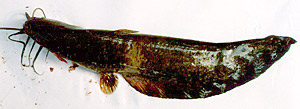 Airsac
Catfish (Heteropneustes fossilis) The peculiar looking
airsac catfish, known from only a few specimens, is an air-breathing,
freshwater fish. A long air sac that extends back from the gill chamber
acts like a lung and enables the catfish to breathe air. It has a long
body that narrows to a pointed head, and four pairs of barbels (fleshy
projections) protrude from around the mouth. The airsac catfish has a
short fin on its back, a long fin on the rear underside of the body, and
a rounded tail fin. Despite their tiny size, airsac catfish are dreaded
by local fisherman due to the sharp poisonous spine in each pectoral fin
that can inflict a painful sting on any person wading in its territory.
Growing up to a foot in length, the airsac catfish is from Pakistan and
Thailand, where it is found in rivers and ponds, in mostly turbid
waters. Although some airsac catfish are raised in aquaculture for food
and medicinal value, this fish's sting can be dangerous to people and
all members of the family Heteropneustidae are prohibited. Airsac
Catfish (Heteropneustes fossilis) The peculiar looking
airsac catfish, known from only a few specimens, is an air-breathing,
freshwater fish. A long air sac that extends back from the gill chamber
acts like a lung and enables the catfish to breathe air. It has a long
body that narrows to a pointed head, and four pairs of barbels (fleshy
projections) protrude from around the mouth. The airsac catfish has a
short fin on its back, a long fin on the rear underside of the body, and
a rounded tail fin. Despite their tiny size, airsac catfish are dreaded
by local fisherman due to the sharp poisonous spine in each pectoral fin
that can inflict a painful sting on any person wading in its territory.
Growing up to a foot in length, the airsac catfish is from Pakistan and
Thailand, where it is found in rivers and ponds, in mostly turbid
waters. Although some airsac catfish are raised in aquaculture for food
and medicinal value, this fish's sting can be dangerous to people and
all members of the family Heteropneustidae are prohibited.
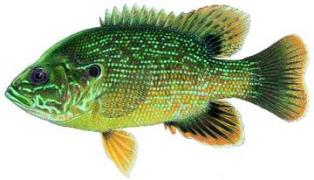 Green
Sunfish (Lepomis cyanellus) A slender bodied bream
with a maximum depth that is less than the distance from the snout to
the origin of the dorsal (most sunfish are deeper bodied), the green
sunfishes mouth is relatively large, extending to the middle of the
eye. It's color is blue-green on it's back with mottled yellow green
streaks. Green sunfish are found in North American lakes and ponds, but
are not naturally found in Florida. Green sunfish grow to about 12
inches in length and can weigh two pounds. Known to rapidly colonize a
water body, green sunfish will then stunt and may also hybridize with
other bream affecting the gene pool, making them a risk for Florida
waters. Green
Sunfish (Lepomis cyanellus) A slender bodied bream
with a maximum depth that is less than the distance from the snout to
the origin of the dorsal (most sunfish are deeper bodied), the green
sunfishes mouth is relatively large, extending to the middle of the
eye. It's color is blue-green on it's back with mottled yellow green
streaks. Green sunfish are found in North American lakes and ponds, but
are not naturally found in Florida. Green sunfish grow to about 12
inches in length and can weigh two pounds. Known to rapidly colonize a
water body, green sunfish will then stunt and may also hybridize with
other bream affecting the gene pool, making them a risk for Florida
waters.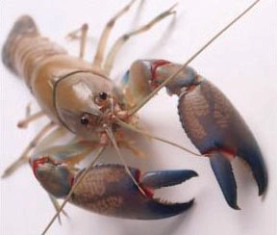 Australian
Crayfish (Cherax) Australian crayfish, except for
tank culture of the red claw crayfish is prohibited due to potential
conflict with numerous threatened native crayfish and impacts on dikes
and the food chain. Australian Red Claw Crawfish differ from Louisiana
crawfish in many ways. They get their name from the red patch found on
the males' claws. They do not burrow in the ground like the crawfish
that we're most familiar with, nor do they attack each other, except
right after a molt. Redclaws grow at least twice as fast as other
crawfish and become much larger. Australian
Crayfish (Cherax) Australian crayfish, except for
tank culture of the red claw crayfish is prohibited due to potential
conflict with numerous threatened native crayfish and impacts on dikes
and the food chain. Australian Red Claw Crawfish differ from Louisiana
crawfish in many ways. They get their name from the red patch found on
the males' claws. They do not burrow in the ground like the crawfish
that we're most familiar with, nor do they attack each other, except
right after a molt. Redclaws grow at least twice as fast as other
crawfish and become much larger. |
|
|
Advertise | Privacy Statement | Dog Encyclopedia | Video |Contact | Alaska Nature |
|